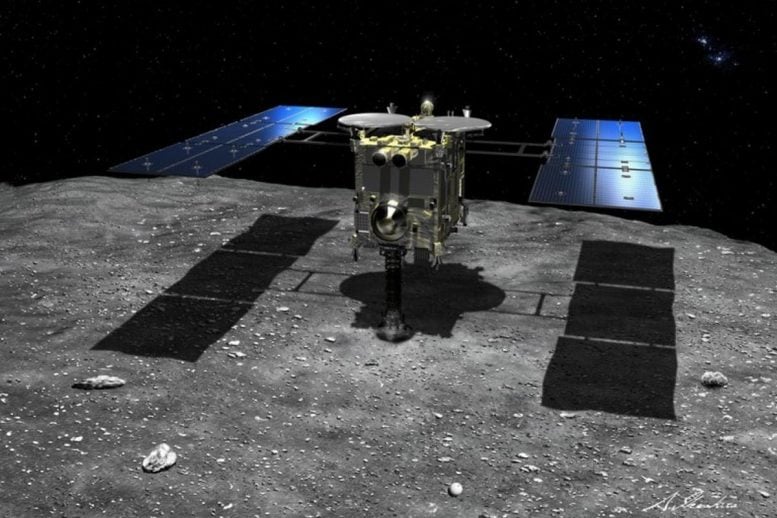
Japan’s Hayabusa2 mission to asteroid Ryugu. Credit: JAXA
Although it has been nearly two years since Japanese mission Hayabusa2 returned to Earth, samples from asteroid Ryugu are still revealing valuable information about the history of the early solar system. A new study reveals the isotopic composition of zinc and copper of asteroid Ryugu. According to the isotopic signatures, Ryugu’s composition is close to Ivuna-like carbonaceous chondrites, and Ryugu-like material from the outer solar system accounts for ~5-6% of Earth’s mass.
These results, by scientists from the Paris Globe Institute of Physics (Institut de Physique du Globe de Paris), Université Paris Cité, and CNRS, as part of an international consortium, are published today (December 12, 2022) in the journal Nature Astronomy.
Meteorites found on Earth provide scientists with samples representing the first moments of the solar system. However, a major step forward was made with the return to Earth in December 2020 of the Hayabusa2 mission, operated by the Japanese space agency JAXA. It brought back 5 grams of fragments from the asteroid Ryugu, offering the possibility of analyzing samples unaltered by their arrival and stay on Earth.
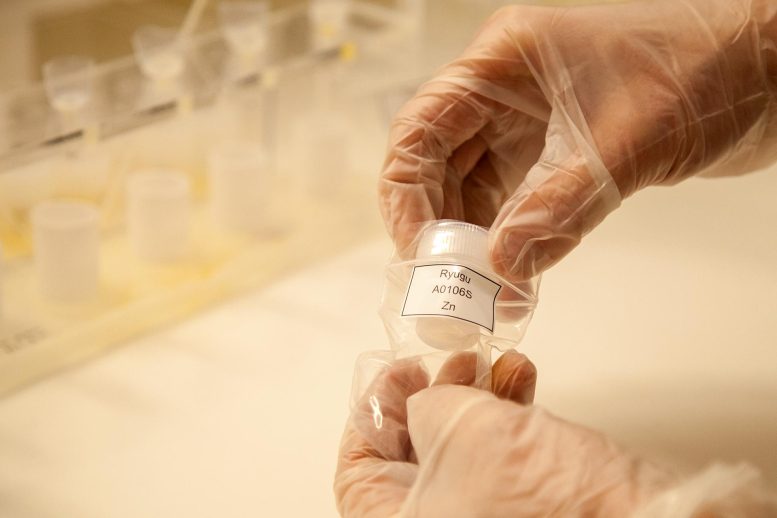
Samples of asteroid Ryugu analyzed at IPGP Credit: © IPGP
The first analyses, carried out by an international team, including researchers from the Paris Globe Institute of Physics, Université Paris Cité, and the CNRS, have shown that the composition of the asteroid Ryugu is close to that of Ivuna-like carbonaceous chondrites (CI) — the most chemically primitive meteorites, and considered to have the composition closest to the Sun. However, some isotopic signatures (e.g., titanium and chromium) overlap with other groups of carbonaceous chondrites, so the details of the link between Ryugu and CI chondrites are not yet fully understood.
Zinc and copper are two moderately volatile elements, and are key elements to study the processes of accretion of volatiles during the formation of telluric planets. The different groups of carbonaceous chondrites show distinct zinc and copper isotopic compositions, with the CI chondrites being the more enriched in volatile elements. By carrying out additional analyzes of the zinc and copper isotopic composition of Ryugu, the scientists had access to a crucial tool for studying the origin of the asteroid.
The international team showed, in a study published on December 12th, 2022 in the journal Nature Astronomy and led by Marine Paquet and Frédéric Moynier, cosmochemists at the IPGP, that the isotopic ratios of copper and zinc in the samples from Ryugu were identical to CI chondrites but different from all other types of meteorites. By finally confirming the similarity between Ryugu and CI chondrites, this study establishes that these primitive samples from Ryugu represent the best estimate of the solar composition to date for copper and zinc.
Finally, the zinc isotopic composition of Ryugu can also be used to study the accretional history of moderately volatile elements on Earth, which are essential for the development of planetary habitability. The study also demonstrates that the contribution of Ryugu-like material represents about 5% of the Earth’s mass.
Reference: “Contribution of Ryugu-like material to Earth’s volatile inventory by Cu and Zn isotopic analysis” by Marine Paquet, Frederic Moynier, Tetsuya Yokoyama, Wei Dai, Yan Hu, Yoshinari Abe, Jérôme Aléon, Conel M. O’D. Alexander, Sachiko Amari, Yuri Amelin, Ken-ichi Bajo, Martin Bizzarro, Audrey Bouvier, Richard W. Carlson, Marc Chaussidon, Byeon-Gak Choi, Nicolas Dauphas, Andrew M. Davis, Tommaso Di Rocco, Wataru Fujiya, Ryota Fukai, Ikshu Gautam, Makiko K. Haba, Yuki Hibiya, Hiroshi Hidaka, Hisashi Homma, Peter Hoppe, Gary R. Huss, Kiyohiro Ichida, Tsuyoshi Iizuka, Trevor R. Ireland, Akira Ishikawa, Motoo Ito, Shoichi Itoh, Noriyuki Kawasaki, Noriko T. Kita, Kouki Kitajima, Thorsten Kleine, Shintaro Komatani, Alexander N. Krot, Ming-Chang Liu, Yuki Masuda, Kevin D. McKeegan, Mayu Morita, Kazuko Motomura, Izumi Nakai, Kazuhide Nagashima, David Nesvorný, Ann N. Nguyen, Larry Nittler, Morihiko Onose, Andreas Pack, Changkun Park, Laurette Piani, Liping Qin, Sara S. Russell, Naoya Sakamoto, Maria Schönbächler, Lauren Tafla, Haolan Tang, Kentaro Terada, Yasuko Terada, Tomohiro Usui, Sohei Wada, Meenakshi Wadhwa, Richard J. Walker, Katsuyuki Yamashita, Qing-Zhu Yin, Shigekazu Yoneda, Edward D. Young, Hiroharu Yui, Ai-Cheng Zhang, Tomoki Nakamura, Hiroshi Naraoka, Takaaki Noguchi, Ryuji Okazaki, Kanako Sakamoto, Hikaru Yabuta, Masanao Abe, Akiko Miyazaki, Aiko Nakato, Masahiro Nishimura, Tatsuaki Okada, Toru Yada, Kasumi Yogata, Satoru Nakazawa, Takanao Saiki, Satoshi Tanaka, Fuyuto Terui, Yuichi Tsuda, Sei-ichiro Watanabe, Makoto Yoshikawa, Shogo Tachibana and Hisayoshi Yurimoto, 12 December 2022, Nature Astronomy.
DOI : 10.1038/s41550-022-01846-1

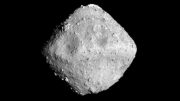
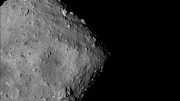
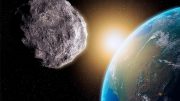
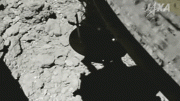
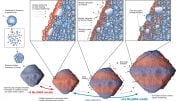
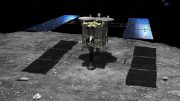
Be the first to comment on "Samples From Asteroid Ryugu Shed New Light on Solar System History"